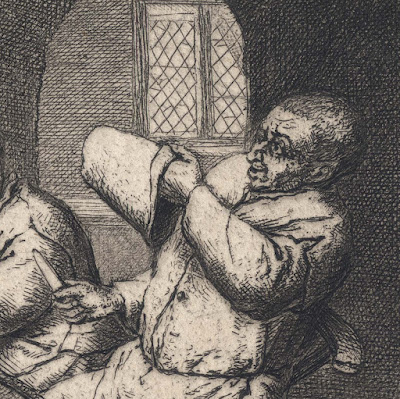Philips Galle (aka Philippe
Galle; Philippus Gallaeus) (1537–1612)
“Duck Hunt with Shotgun” (TIB title),
1578, from the series of 43 plates, “Hunting Parties” (aka “Venationes Ferarum,
Avium, Piscium” (transl. “With wild beasts, birds, fish”), after Jan van der
Straet (aka Joannes Stradanus; Ioannes Stradanus) (1523–1605). This
impression is presumably from the first edition of 1578 published in Antwerp
before the number “72” is added in the later expanded edition of plates.
Engraving on laid paper with small margins,
backed with a support sheet.
Size: (sheet) 22.5 x 32.5 cm; (plate)
21.3 x 30.2 cm; (image borderline) 20.5 x 30.2 cm
Inscribed on plate within image
borderline at lower left: “Iohan/ Stra. inuen.”
Lettered in Latin on plate below the
image borderline: “Sic per fecta repens venator consita dumis, Torquet et
undosos Anates, Fulicasq[ue] palustres.” (Unmodified transl. “Thus the
ingredients recent hunter planted with bushes, twists and rolling ducks,
Fulicasque marsh."
State: i (of iii) before numbering in
state ii.
TIB 5601.104:29 (Walter L Strauss &
Arno Dolders [eds.] 1987, “The Illustrated Bartsch”, vol. 56, Supplement, p. 429);
New Hollstein (Dutch & Flemish) 449.I (Johannes Stradanus); New Hollstein
(Dutch & Flemish) 547.I (Philips Galle); Baroni Vannucci 1997 693.72 (Alessandra
Baroni Vannucci 1997, “Jan van der Straet, detto Giovanni Stradano, flandrus
pictor et inventor”, Milan, Jandi Sapi Editori).
The British Museum offers the following description of this print from the later numbered state/edition:
“Plate numbered 72, Duck Hunt with
Shotguns; in the left foreground, four hunstman, armed with shotguns,
accompanied by two dogs, approach a river to the right, in which ducks are seen
swimming; in the midground, far left, two men pull ropes, closing a net over a
flock of ducks, centre; several towns visible in the distance”
See also the description of this print
at the Rijksmuseum:
Condition: crisp lifetime impression (before
numbering of later editions), but not as richly inked as some impressions.
There is a dot stain at the upper left edge of the image borderline and a closed
tear at the lower edge to the right of the word “repens”, otherwise the impression is in excellent
condition and backed with a support sheet of archival (millennium quality)
washi paper.
I am selling this exceptionally rare,
engraving from 1578 for a total cost of AU$256 (currently US$185.10/EUR158.80/GBP142.48
at the time of this listing) including postage and handling to anywhere in the
world.
If you are interested in purchasing this
important print foreshadowing Ruben's "The Lion Hunt" (1621), please
contact me (oz_jim@printsandprinciples.com) and I will send you a PayPal
invoice to make the payment easy.
This print has been sold
After closely examining the impression
of this print held by the British Museum (http://www.britishmuseum.org/research/collection_online/collection_object_details.aspx?objectId=1620708&partId=1&searchText=stradanus+&page=6)
and comparing the BM impression with the print in “The Illustrated Bartsch” catalogue
raisonné for Galle and the impression held by the Rijksmuseum (http://hdl.handle.net/10934/RM0001.COLLECT.114988),
I have come to the conclusion that the BM’s impression is not by Galle. Compare,
for example, the cross-hatching surrounding the dog portrayed near the centre
of the composition and the rather sloppy drawing of the figure loading his gun
in the BM’s copy with this impression. Note also that the lettered text shown
in the BM’s impression is not the same as Galle’s original. The good news is
that the impression that I am showcasing matches perfectly the image and text reproduced
in TIB and held by the Rijksmuseum. (Thank Goodness!)
Leaving aside the issue of attribution,
I wish to draw attention to what I see as the very curious composition of this
print. For instance, my eye is drawn to the very strange arrangement of the dog
at the centre of the scene which is so perfectly placed between the two musket
toting huntsmen that the dog seems like a cut-out. Note also the same perfectly
centred arrangement of the distant circular hedged bird trap seemingly fitted
between the two large trees on each side of the trap. For me this striving for perfect
symmetry seems unsettlingly curious but there is one other extra strange
arrangement in this composition: the strong “V”-shape created by the muskets
held by the chaps.
I may be very incorrect in my assessment
of what this means but I wonder if the dynamic downward plunge of this “V”-shape
is a analogue for the artist’s depressed mindset when he made this engraving.
If this is the case, the broken—perhaps torn—arrangement of river rocks on the
lower right makes sense in terms of signifying a trouble spirit.





















































